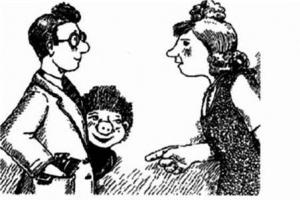Hormones influence the mechanisms of emotion formation and the action of various neurochemicals, and, as a result, are involved in the formation of stable habits. The author of the book “Happiness Hormones,” Professor Emeritus of the University of California Loretta Graziano Breuning, suggests reconsidering our behavior patterns and learning to trigger the action of serotonin, dopamine, endorphin and oxytocin. T&P publishes a chapter from a book about how our brains self-tune, responding to experience and forming neural connections accordingly.
Loretta Graziano Breuning
founder of the Inner Mammal Institute, professor emeritus at the University of California, author of several books, blogs “Your Neurochemical Self” on PsychologyToday.com
Rearranging neural pathways
Each person is born with many neurons, but very few connections between them. These connections are built as we interact with the world around us and ultimately make us who we are. But sometimes you have a desire to slightly modify these formed connections. It would seem that this should be easy, because we developed them without much effort on our part in our youth. However, the formation of new neural pathways in adulthood is unexpectedly difficult. Old connections are so effective that giving them up makes you feel like your survival is at risk. Any new nerve chains are very fragile compared to the old ones. When you can understand how difficult it is to create new neural pathways in the human brain, you will be more pleased with your persistence in this direction than berate yourself for the slow progress in their formation.
Five Ways Your Brain Self-Tunes
We mammals are able to create neural connections throughout our lives, unlike species with stable connections. These connections are created as the world around us affects our senses, which send corresponding electrical impulses to the brain. These impulses pave neural pathways along which other impulses will run faster and easier in the future. Each individual's brain is wired for an individual experience. Below are five ways that experience physically changes your brain.
Life experiences insulate young neurons
Over time, a constantly working neuron becomes covered with a sheath of a special substance called myelin. This substance significantly increases the efficiency of the neuron as a conductor of electrical impulses. This can be compared to the fact that insulated wires can withstand a significantly greater load than bare wires. Neurons coated with myelin work without the extra effort that slow, “open” neurons have. Neurons with a myelin sheath appear white rather than gray, which is why we divide our brain matter into “white” and “gray.”
Most of the covering of neurons with myelin is complete by the age of two years, as the child's body learns to move, see and hear. When a mammal is born, its brain must form a mental model of the world around it, which will provide it with opportunities for survival. Therefore, myelin production in a child is maximum at birth, and by the age of seven it decreases slightly. By this time you no longer need to relearn the truth that fire burns and gravity can make you fall.
If you think that myelin is “wasted” on strengthening neural connections in young people, then you should understand that nature designed it this way for sound evolutionary reasons. For most of human history, people had children as soon as they reached puberty. Our ancestors needed to have time to solve the most urgent tasks that ensured the survival of their descendants. As adults, they used new neural connections more than reconfigured old ones.
When a person reaches puberty, the formation of myelin in his body is activated again. This happens because the mammal has to re-tune its brain to find the best mate. Often during the mating season, animals migrate to new groups. Therefore, they have to get used to new places in search of food, as well as to new tribesmen. In search of a marriage partner, people are also often forced to move to new tribes or clans and learn new customs and culture. The increase in myelin production during puberty contributes to all this. Natural selection has designed the brain in such a way that it is during this period that it changes the mental model of the world around it.
Everything you do purposefully and consistently during your “myelin prime” years creates powerful and extensive neural pathways in your brain. This is why human genius so often manifests itself in childhood. That is why little skiers fly past you so dashingly on mountain slopes that you cannot master, no matter how hard you try. This is why learning foreign languages becomes so difficult once adolescence ends. As an adult, you can memorize foreign words, but most often you cannot quickly select them to express your thoughts. This happens because your verbal memory is concentrated in thin, unmyelinated neurons. Your powerful myelinated neural connections are busy with high mental activity, so new electrical impulses have difficulty finding free neurons. […]
Fluctuations in the body's activity in the myelination of neurons can help you understand why people have certain problems at different times in life. […] Remember that the human brain does not mature automatically. Therefore, it is often said that the brain of adolescents is not yet fully formed. The brain “myelinates” all our life experiences. So if there are episodes in a teenager’s life when he receives an undeserved reward, he will firmly remember that the reward can be received without effort. Some parents forgive their teens' bad behavior by saying that "their brains haven't fully matured yet." That is why it is very important to purposefully control the life experience that they absorb. Allowing a teenager to avoid responsibility for his actions can create a mind that will expect the possibility of avoiding such responsibility in the future. […]

Life experience increases synapse efficiency
A synapse is a point of contact (small gap) between two neurons. An electrical impulse in our brain can only travel if it reaches the end of a neuron with enough force to “jump” across the gap to the next neuron. These barriers help us filter truly important incoming information from irrelevant so-called “noise.” The passage of an electrical impulse through synaptic gaps is a very complex natural mechanism. It can be imagined in such a way that a whole flotilla of boats accumulates at the tip of one neuron, which transports the neural “spark” to special receiving docks available at a nearby neuron. Each time the boats cope better with transportation. This is why the experiences we have increase the chances of electrical signals being transmitted between neurons. The human brain has more than 100 trillion synaptic connections. And our life experience plays an important role in conducting nerve impulses through them in a way that is consistent with the interests of survival.
At a conscious level, you cannot decide which synaptic connections you want to develop. They are formed in two main ways:
1) Gradually, through repeated repetition.
2) Simultaneously, under the influence of strong emotions.
[…] Synaptic connections are built based on repetition or emotions you have experienced in the past. Your mind exists because your neurons have formed connections that reflect successful and unsuccessful experiences. Some episodes from this experience were “downloaded” into your brain thanks to “joy molecules” or “stress molecules”, others were fixed in it through constant repetition. When the model of the world around you corresponds to the information contained in your synaptic connections, electrical impulses run through them easily, and it seems to you that you are quite aware of the events happening around you.
Neural chains are formed only due to active neurons
Those neurons that are not actively used by the brain begin to gradually weaken as early as a two-year-old child. Oddly enough, this contributes to the development of his intelligence. Reducing the number of active neurons allows the baby not to glance distractedly at everything around him, which is typical for a newborn, but to rely on the neural pathways that have already been formed. A two-year-old child is already able to independently concentrate on what gave him pleasant sensations in the past, such as a familiar face or a bottle of his favorite food. He may be wary of things that have caused him negative emotions in the past, such as a pugnacious playmate or a closed door. The young brain relies on its limited life experience to meet needs and avoid potential threats.
No matter how the neural connections in the brain are built, you experience them as “truth”
From the age of two to seven years, the process of optimizing the child’s brain continues. This forces him to correlate new experiences with old ones, instead of accumulating new experiences in some separate block. Tightly intertwined neural connections and neural pathways form the basis of our intelligence. We create them by branching out old neural trunks instead of creating new ones. Thus, by the age of seven, we usually clearly see what we have already seen once, and hear what we have already heard once.
You might think this is bad. However, consider the value of it all. Imagine lying to a six-year-old child. He believes you because his brain eagerly absorbs everything that is offered to him. Now suppose you deceive an eight-year-old child. He is already questioning your words because he compares incoming information with what he already has, and does not simply “swallow” new information. At the age of eight, it is already more difficult for a child to form new neural connections, which pushes him to use existing ones. Relying on old neural circuits allows him to recognize lies. This was of great importance from a survival point of view at a time when parents died young and children had to learn to take care of themselves from an early age. During our young years, we form certain neural connections, allowing others to gradually fade away. Some of them disappear like the wind blows away autumn leaves. This helps make a person's thought process more efficient and focused. Of course, with age you gain more and more knowledge. However, this new information is concentrated in areas of the brain where active electrical pathways already exist. For example, if our ancestors were born into hunting tribes, they quickly gained hunter experience, and if they were born into farming tribes, they quickly gained agricultural experience. Thus, the brain was tuned to survival in the world in which they actually existed. […]

New synaptic connections are formed between the neurons you actively use
Each neuron can have many synapses because it has many processes or dendrites. New processes in neurons are formed when it is actively stimulated by electrical impulses. As dendrites grow toward points of electrical activity, they can get so close that an electrical impulse from other neurons can bridge the distance between them. In this way, new synaptic connections are born. When this happens, at the level of consciousness you get a connection between two ideas, for example.
You cannot feel your own synaptic connections, but you can easily see it in others. A person who loves dogs looks at the entire world around him through the prism of this affection. A person who is passionate about modern technologies associates everything in the world with them. A lover of politics evaluates the surrounding reality politically, and a religiously convinced person evaluates it from the standpoint of religion. One person sees the world positively, another - negatively. No matter how the neural connections in the brain are built, you do not feel them as numerous processes similar to the tentacles of an octopus. You experience these connections as “truth.”
Emotion receptors develop or atrophy
In order for an electrical impulse to cross the synaptic cleft, the dendrite on one side must eject chemical molecules that are picked up by special receptors on the other neuron. Each of the neurochemicals produced by our brain has a complex structure that is perceived by only one specific receptor. It fits the receptor like a key to a lock. When you are overwhelmed by emotions, more neurochemicals are produced than the receptor can catch and process. You feel dazed and disoriented until your brain creates more receptors. This is how you adapt to the fact that “something is happening around you.”
When a neuron's receptor is inactive for an extended period of time, it disappears, leaving room for other receptors that you may need to appear. Flexibility in nature means that receptors on neurons must either be used or they can be lost. “Happy hormones” are constantly present in the brain, searching for “their” receptors. This is how you “find out” the reason for your positive feelings. The neuron “fires” because the appropriate hormone molecules open the lock on its receptor. And then, based on this neuron, a whole neural circuit is created that tells you where to expect joy in the future.
Images: © iStock.
Has a neural structure. It is fixed in the brain in the form of a neural formation.
The number of neurons is huge. Scientists put numbers between 10 and 100 billion. Neurons are nerve cells in our brain that conduct nerve impulses. Impulses travel at enormous speed: the distance from one neuron to another message travels in less than 1/5000 of a second. Thanks to this we feel, think, act.
When a person is born, he already has a large number of neural formations responsible for the functioning of internal organs, respiratory systems, blood supply, removal of body waste and others. From birth to two years, the number of neural formations in a person increases significantly, as he learns to walk, talk, recognize objects and people, and gains experience getting to know the world around him. Resources that are external to a newborn person quickly become internal, inseparable from the personality.
How are neural formations formed?
Each neuron is similar to the root system of a plant, where there is one large root (axon), and there are branches from this root (dendrites).
Every time a message passes through the brain, many nerve impulses jump from one neuron to another.
The transmission of such messages does not occur directly, but through an intermediary. A mediator is a chemical substance called a neurotransmitter. When transmitting messages, one neuron accumulates transmitters at the tip of the “root” and then lets them “free float”. The task of mediators is to transfer a nerve impulse to another neuron through a certain barrier (synapse). Transmitters can only land at a specific location on a neighboring neuron. And the mooring point accepts only one type of mediators. But the transmitter itself can attach to more than one neuron.
Depending on the message carried by the neurotransmitter, the nerve impulse either continues on its way or stops right there. While the second neuron “reads” the message and “decides” whether the nerve impulse will continue its path further, the transmitter remains at the pier.
If the neuron “decides” what to do next, either the impulse travels further along the chain, or the information in the neuron is neutralized and the transmitter is destroyed. This impulse transfer system helps us filter truly important incoming information from irrelevant so-called “noise.”
If messages are repeated, mediators quickly and easily reach the mooring point on a neighboring neuron, and a stable neural connection is formed.
Since neurons have many dendrites, a neuron can simultaneously form many transmitters with different messages for other neurons.
Previously, scientists believed that the connections between neurons are fixed at birth and are not influenced by human experience. Today the opinion has changed. How many such connections will be created by the nervous system is greatly influenced by the events of our lives - by the huge diversity of what we absorb into ourselves from infancy. As we learn new skills and encounter new feelings in a complex neural network, we constantly form new connections. Therefore, the interneuron connections of the brain for each of us have a unique structure.
At the same time, we can rebuild the brain by creating new neural connections, this ability of the brain is called neuroplasticity.
Resource as a neural connection.
Any internal resource is, in fact, a skill, a strong neural connection. A strong neural connection is formed in two main ways:
1. Simultaneously, under the influence of strong emotions.
2. Gradually, through repeated repetition.
For example, when a person learns to drive a car, there is no structure or neural connection yet. The driving skill has not yet been developed, the resource is still external. In order to hold the steering wheel, press the pedals, turn on the turn signals, react to signs and road conditions, and regulate the level of fear and anxiety, a lot of energy is required.
This is the energy of attention and the energy of motivation. Hand here, foot here, look in the mirrors, and there is a pedestrian, and also signs and other cars. Tension and anxiety out of habit. If the energy of motivation is spent, plus there is a colossal loss of energy of attention, and they are not compensated by the pleasure of the driving process, then a person often postpones training until better times.
If the stress from such “driving” is not so great and is covered by pleasure, then the person will learn to drive. Over and over again, neurons in the human brain will be arranged in a certain configuration that ensures the process of acquiring the skill of driving.
The more repetitions there are, the faster new neural connections will be formed. But only if the energy spent on acquiring the skill is compensated in excess.
Moreover, neural connections will be formed not in one place, but in several areas of the brain that are involved when a person drives a car.
In the future, less energy will be needed for the driving process, and the easier and more enjoyable the process will be. Neural connections have been formed, and now the task is to “settle” these connections, sew them into the subcortex, so that they turn into a stable neural formation. And the better a person does, the more pleasure and positive reinforcement he gets, the faster the work goes.
When the neural formation is formed, the system becomes autonomous, less and less energy is required, it begins to flow rather than be spent. It is then that the external resource becomes internal.
And now a person can listen to music, talk, think about his own things, and his mind will follow the road, his body will perform the necessary actions on its own, and even in an extreme situation, the mind and body will cope on their own, without the participation of consciousness, and will take the necessary measures. This is exactly what happened to me when I fell out of reality and did not remember how I came home. I wrote about this
And if you add an element of creativity here, the neural structure in the brain will become even more beautiful, complex and flexible.
Any resource can be upgraded to such an extent that it becomes a skill built into the personality through the neural structure.
Neural connections and internal control.
Any actions have some kind of developmental effect only when they occur on the verge of losing control over the situation. And the more pronounced this facet is, the greater the effect. Loss of control forces us to form new neural connections, making the structure more extensive.
And this vastness is achieved by capturing “open” neurons into the network.
Look, a constantly working neuron eventually becomes covered with a sheath of a special substance called myelin. This substance significantly increases the efficiency of the neuron as a conductor of electrical impulses. Neurons covered with a myelin sheath work without expending unnecessary energy. Neurons with a myelin sheath appear white rather than gray, which is why we divide our brain matter into “white” and “gray.” Typically, the covering of neurons by the membrane in humans is active up to two years, and decreases by seven years.
There are “open” neurons that are poor in myelin, in which the impulse conduction speed is only 1-2 m/s, that is, 100 times slower than that of myelinated neurons.
Loss of control forces the brain to “search” for and connect “open” neurons into its network to form a new piece of neural formation “responsible” for new experiences.
That is why we are simply not interested in performing actions in which the possibility of losing control is completely excluded. They are boring and routine, and do not require much brain activity. And if the brain does not receive enough activity, it degrades, unused neurons die off, the person becomes dull and stupid.
If the loss of control each time leads to the formation of the desired result, then we speak of positive reinforcement.
This is how children learn to walk, ride a bike, swim, and so on. Moreover, the more hours spent on some activity, the more myelinated neurons in the brain, which means the higher its productivity.
One convincing piece of evidence came from a brain scan of a professional musician. There has been a lot of research into how the musician's brain differs from the brain of ordinary people. In these studies, the brain was scanned in a diffusion MRI machine, giving scientists information about the tissue and fibers within the scanned area.
The study found that piano practice promoted the formation of white matter in areas of the brain associated with finger motor, visual and auditory processing centers, but other areas of the brain were no different from those of the “average person.”
Internal control and habits.
Modern neurophysiology knows that time for the formation of a branched structure of neuron processes – 40-45 days, and the time required for formation of new neurons – 3-4 months.
Therefore, in order for a resource to turn from external to internal, it is enough to form a NEW neural formation for a specific task. This will take at least 120 days.
But under three conditions.
- The resource must be pumped daily.
- It must be accompanied by loss
- Energy must be compensated in excess.
Let's return to the car example. Loss of internal control occurs every time a driver gets behind the wheel. Moreover, this does not depend on driving experience. The driver is always making internal adjustments to the car and the road, to road users, and to weather conditions. The mobilization of internal resources is always ongoing, even among the most experienced.
The difference between an experienced and a novice driver will be that the experienced one has already acquired stable neural connections and the amplitude of loss of control is not felt by him. But an inexperienced driver can lose control so much that nervous tension will be visible to the naked eye. But the more often and longer such a driver drives, the faster and better he will cope with the situation of loss of control.
After 120 days, driving skill will become a HABIT, that is, it will not take away all the free energy. A person will already be able to play music in the car, or have conversations with passengers. The newly formed neural formation is still not stable, but already performs a function for a specific task.
If a person develops the driving skill longer, then after some time the neural formation responsible for this skill will become stable, autonomous, and stable. If a person does not use the newly created neural formation, then after some time it will disintegrate and collapse. Therefore, often people who have a license cannot drive a car.
Any other resource is made internal according to the same principle. An internal resource is nothing more than the formation of stable neural connections in the brain structures, characterized by an increased readiness for functioning compared to other neural response chains.
The more we repeat any actions, thoughts, words, the more active and automatic the corresponding neural pathways become.
All this is true for the formation of “bad” habits. And here I’m talking not only about alcohol and drugs, but also about the habit of complaining about life, whining, blaming everyone and everything for your difficult life, being mean, going over your head, being cunning and dodging to get what you need.
Here, too, there is conditional “positive” reinforcement, when a person receives what he needs through such actions. And remembers this as the “correct” path leading to the result.
There are also neural formations responsible for patterned attitudes, limiting beliefs, and persistent programs that a person cannot get rid of for years. These neural formations are especially strong in the area of money, self-confidence, and in the area of human relationships. These neural formations are formed long before the child can consciously approach these issues. The formation of limiting beliefs and various emotional blocks occurs under the influence of parents and society.
And it also very much depends on the environment, country, history, mentality.
These long-standing, stable neural formations can be destroyed. This requires from 1 to 5 years of daily “work”.“Works” on the formation of NEW beliefs, NEW actions, NEW environment. Then, in place of some neural formations, others will appear.
Considering that limiting beliefs take decades to form, the opportunity to remove them in just three years seems tempting.
Yes, easy to say, not easy to do. To “think about it”, here’s a story for you.
Imagine you have received an inheritance - a 100-hectare subsoil plot for diamond mining.
You have entered into inheritance rights and then representatives of the Diamond Corporation contact you. Like, we want to lease your plot for 50 years, everything we get is ours, and we will pay you a fixed rent monthly during these 50 years.
You thought and agreed. So what? There is money for the most necessary things, and my head doesn’t hurt about where to get it.
The Diamond Corporation has caught up with equipment and people, and work has begun.
From time to time you look at how they do it, whether it works. And after a while you realize that, to put it mildly, you sold yourself short. But a contract is a contract; it can neither be terminated prematurely nor rejected.
After a couple of years, you realize that it’s not just that you cheapened out, you screwed up with the site... Judging by the reports, the Diamond Corporation is doing very well. You understand that in 50 years it is unlikely that you will be able to dig up at least one diamond lying there. And inflation eats up your rent every year.
You hire a lawyer to negotiate with Diamond Corporation. You want to either increase your rent or maybe your share of the profits.
No problem, they say at the corporation, we are ready to renegotiate the terms of the contract and increase your rent for the same 50 years.
And then your lawyer tells you that he has found a loophole in the contract, a completely legal one, and the contract can be terminated completely officially, and without penalties.
Now you have two options:
- Terminate the contract and the plot becomes your property again;
- Keep silent about the loophole and agree to the rent.
What will you do? Write in the comments or on a piece of paper. What's your logic?

Well, did you write it?
And now the continuation.
The diamond site is you.
And the diamonds in it are yours. Managing your development, your habits, is like managing your own diamond plot. And even if you think that you do not have an area with diamonds, but a desert or swamp, maybe you haven’t explored it well?
P.S. The case with diamonds was stolen from Elena Rezanova.
When the ancient Egyptians prepared a mummy, they scraped out the brain through the nostrils and discarded it. While other organs were preserved and ended up in the grave, the brain was seen as something separate from the rest of the body and as something unnecessary for life after death. Eventually, of course, healers and scientists realized that the three pounds of intertwined neurons located under our skulls perform some very important functions. But even today, the brain is often seen as something different from the rest of the body: it is a neurobiological reservoir that secretly controls our bodies and minds through unique biology and unique pathologies.
Perhaps the most frequently cited difference between the body and the brain is the relationship to the immune system. When exposed to foreign bacteria, viruses, tumors, and transplanted tissue, the body produces a flurry of immune activity: white blood cells devour invading pathogens and destroy damaged cells; Antibodies mark foreign elements for their subsequent destruction. But in the brain everything happens differently. It was thought to be too vulnerable to the large-scale presence of formidable defense cells, and so it was assumed that the brain was protected from such immune cascades.
However, a study published this month provides evidence of a previously unknown communication channel between our brain and immune system. Recently, a rapidly growing body of research suggests that the brain and body are, in fact, more connected than is commonly believed. This recent research may have important implications for the understanding and treatment of brain disorders.
As early as 1921, scientists realized that the brain was something special - from an immunological point of view. Foreign tissue implanted in most areas of the body often causes an immunological attack; however, tissue implanted into the central nervous system produces a significantly less hostile response. This is due in part to the blood-brain barrier, consisting of cells tightly packed in the brain's blood vessels that allow nutrients to pass through but mostly keep invaders such as bacteria and viruses out. The brain itself has long been considered "immunologically privileged," meaning that it is able to withstand invasion by external pathogens and tissues. The central nervous system was viewed as existing independently of the peripheral immune system and as having its own less aggressive immune system.
It was also generally believed that the advantage of the brain was due to its lack of lymphatic drainage. The lymphatic system is considered the third largest in our body and, perhaps, it is the least considered transport system - unlike the arterial and venous. Lymphatic vessels return extracellular fluid to the bloodstream, while lymph nodes—which appear periodically along the vascular system—serve as storage for immune cells. In the vast majority of parts of the body, antigens—molecules in pathogens or foreign tissue that alert our immune system to potential threats—meet white blood cells in our lymph nodes and trigger an immune response. However, it was previously believed that such things did not happen in the brain due to the lack of a lymphatic network, which is why the latest discoveries represent a dogmatic shift in the understanding of how the human brain interacts with the immune system.
Lead author of the study, University of Virginia neurobiology professor Dr. Jonathan Kipnis, and his team, working primarily with mice, discovered a previously unknown network of lymphatic vessels in the meninges—the membranes surrounding the brain and spinal cord—by which transports fluid and immune cells from the cerebrospinal fluid to groups of lymph nodes in the neck - the deep cervical lymph nodes. Kipnis and his colleagues had previously shown that one type of white blood cell (called T lymphocytes) in the pia mater was associated with significant effects on cognition, so they sought to understand the impact of pia mater immunity on brain function. By preparing entire mouse pia maters and using neuroimaging, his team found that T cells were present in vessels separate from arteries and veins, confirming that the brain actually has a lymphatic system that directly links it to the peripheral immune system. system. “We discovered these vessels completely unexpectedly,” Kipnis emphasized.
Recently discovered vessels - they have also been identified in the human body - can explain a variety of pathophysiological mysteries, including answering the question of how the immune system contributes to the development of various neurological and psychiatric diseases. “It’s too early to speculate,” says Kipnis, “but I think that the changes that occur in these vessels may have an impact on the course of the disease in those neurological disorders that are associated with a significant immune component, including multiple sclerosis, autism and Alzheimer’s disease.”
For example, multiple sclerosis, at least in some cases, may result from autoimmune activity in response to infection in the central nervous system or cerebrospinal fluid. It is possible that antigens from infected pathogens enter the cervical lymph nodes through the meningeal lymphatic vessels, and this causes an immune response that causes multiple sclerosis. It is generally accepted that Alzheimer's disease occurs due to the accumulation and entry into the brain of a protein called amyloid. It is possible that amyloid is not completely cleared through these lymphatic vessels, and perhaps increasing their permeability will help the brain get rid of the pathogenic protein.
Another recently published study by Kipnis and colleagues suggests that damage to the central nervous system can lead to significant activation of T cells deep in the cervical lymph nodes. Kipnis believes that some components may be released from the damaged central nervous system and transmitted to deep cervical lymph nodes through lymphatic vessels, which activate the immune system there. A similar scenario may occur in other neurological conditions; and too much or too little drainage from the central nervous system into the immune system may contribute to the development of brain disease. If that's the case, Kipnis says drugs, gene manipulation and surgery could be therapeutic options worth exploring.
Dr. Josep Dalmau, a professor of neurology at the University of Pennsylvania who was not involved in the recent research, agrees that the findings help explain the onset, progression and possibly worsening of autoimmune disorders that affect the brain. He also believes that, in light of new data obtained, the relevant textbooks may need to be revised. “It is becoming increasingly clear that (the central nervous system) is immune distinct, not immune privileged,” he notes.
It has been obvious for decades that there is a definite connection between the brain and the immune system. Abnormal immune activity in the 1930s was defined as schizophrenia, and numerous mental and neurological diseases contained, as was then generally believed, an immune component. However, Kipnis's team has been able to identify the actual anatomical structure that facilitates this relationship, suggesting that the brain and body are closely connected and that the human brain is not some kind of citadel, as previously thought.
Have you ever wondered what causes muscles to contract? How do we control our limbs? And in general, how does it work? After all, all top athletes are well aware of the neuromuscular (mental) connection, because They have it very well developed, thanks to years of training. In this article we will try to answer all these questions.
What is the neuromuscular (mental) brain-muscle connection?
Neuromuscular connection- this is the connection between your brain and muscles, which is carried out by the NR (nervous system), through which these signals pass. In simple terms, this is the feeling of muscle contraction, how well you feel a certain working muscle or muscle group in an exercise. Let's say you do regular push-ups and work your pecs, but the next day it's not your pecs that hurt, but your triceps. This suggests that you have poor neuromuscular communication and have poor feel for the muscle group being worked, or you simply performed the exercise incorrectly from a technical point of view. That is, this skill allows you to master the process (contraction) of a certain muscle or muscle group with the help of the brain (the power of thought). Do you strengthen your grip, do you push the projectile at a certain speed, do you strain or contract your muscles without additional. weights or simply raising or bending your arm - all this (all these processes) is carried out due to neuromuscular connections.
What does the neuromuscular connection between the brain and muscles give us?

 The connection between muscles and brain is a very useful skill because... this ability allows you to feel and control the tension in your muscles. Simply put, the stronger the brain is connected to the muscles, the better we will be able to feel them and, accordingly, control them. Pay attention to top bodybuilders or just look at a photo of Schwarzenegger, his muscles are the fruit of well-established work between the brain and muscles. The volume of his arms or chest suggests that he clearly felt all his muscles well. He sweated in the gym for years, established a mental connection with the help of this, ate well, rested, and all this together gave a colossal result. Therefore, if you want to make your body strong, beautiful and functional, you must establish neuromuscular connections and feel your muscles.
The connection between muscles and brain is a very useful skill because... this ability allows you to feel and control the tension in your muscles. Simply put, the stronger the brain is connected to the muscles, the better we will be able to feel them and, accordingly, control them. Pay attention to top bodybuilders or just look at a photo of Schwarzenegger, his muscles are the fruit of well-established work between the brain and muscles. The volume of his arms or chest suggests that he clearly felt all his muscles well. He sweated in the gym for years, established a mental connection with the help of this, ate well, rested, and all this together gave a colossal result. Therefore, if you want to make your body strong, beautiful and functional, you must establish neuromuscular connections and feel your muscles.
How does the neuromuscular/mental connection (mind-muscle) work?

 It's all about impulses. When we want to do any action or allow a contraction, our brain at this time sends signals to our muscles. The decisive factor here is the impulses, or rather their quality & quantity, i.e. the more nerve impulses there are, the higher the strength of each impulse + the frequency with which these impulses are transmitted from the brain to the muscles, the more resistance you create or the amount of force you work with. The better this connection is established, the better you will be able to control the compressive force, and your brain will also learn to conserve energy, directing the flow of force only in the right direction, while preserving the supporting muscles. Those. Before performing any action, the brain first evaluates which muscles need to be used the most and least, it also needs to take into account the applied force, the force of compression and the sequence of muscle contraction. A certain section (zone) of the brain, which is drawn in blue, is responsible for all this (see figure below):
It's all about impulses. When we want to do any action or allow a contraction, our brain at this time sends signals to our muscles. The decisive factor here is the impulses, or rather their quality & quantity, i.e. the more nerve impulses there are, the higher the strength of each impulse + the frequency with which these impulses are transmitted from the brain to the muscles, the more resistance you create or the amount of force you work with. The better this connection is established, the better you will be able to control the compressive force, and your brain will also learn to conserve energy, directing the flow of force only in the right direction, while preserving the supporting muscles. Those. Before performing any action, the brain first evaluates which muscles need to be used the most and least, it also needs to take into account the applied force, the force of compression and the sequence of muscle contraction. A certain section (zone) of the brain, which is drawn in blue, is responsible for all this (see figure below): 

The figure above shows the area of the brain (motor/motor area) that is responsible for the very signals (nerve impulses) that coordinate the work of all motor functions and movements. Those. Before you perform any action, the premotor zone (responsible for orientation, control of the head and eyes) is first turned on, and after it the motor zone is connected, with the help of which the process itself is carried out. Also, depending on the complexity of the action being performed, other areas of the brain are also involved in the work (for example, playing the guitar or drums), but this is another, separate topic.
How to establish a mental connection between the brain and muscles?
The first thing that is necessary in order to establish a mental/neuromuscular connection is to perform any exercise correctly from a technical point of view. The second, and perhaps most important, is the weight. It is important to work with relatively light weights for a long time. For what? All this is done so that you can fully concentrate on the very muscle groups that are actively involved and contracted in the exercise. You can also, outside the gym or just before going to bed, perform imitation exercises without load (which will create an imitation of the movement when performing the exercise); during these movements it is important to fully concentrate on the working muscle group that is involved in this exercise. It is recommended to perform these complexes on an ongoing basis, in the evening or before bed. Because Scientists have long found out that this is the time that is best suited for the brain to create and establish new connections for accelerated work and increased productivity. Thanks to such simple simulated workouts, you will learn to feel your muscles and control them well. Those. if you tense some muscles without load (for example, pectoral muscles), this will indicate good and well-established functioning of the neuromuscular connection.
These skills will allow you to increase the impact of your training, because only target muscle groups (bundles) will be loaded, which will allow you to correctly distribute the load during training and increase efficiency.
For many years, scientists thought that the adult brain remained unchanged. However, science now knows for sure: throughout our lives, more and more synapses are formed in our brain - contacts between neurons or other types of cells that receive their signals. In total
neurons and synapses form a neural network, the individual elements of which are constantly in contact with each other and exchange information.
It is neural connections that help different areas of the brain transmit data to each other, thereby ensuring vital processes for us: memory formation, production and understanding of speech, control of the movements of our own body. When neural connections are disrupted, which can happen as a result of diseases such as Alzheimer's disease or physical trauma, certain areas of the brain lose the ability to communicate with each other. As a result, it becomes impossible to perform any action, both mental (memorizing new information or planning one’s actions) and physical.
A team of researchers led by Stephen Smith from the Center for Functional Magnetic Resonance Imaging of the Brain at the University of Oxford decided to find out whether the total number of neural connections in the brain could somehow influence its overall functioning. During the study, scientists used data obtained as part of Human Connectome Project- a project launched in 2009. Its goal is to compile a kind of “map” of the brain, with the help of which it will be possible to understand which area of the brain is responsible for a particular process or disease, as well as how different areas of the brain interact with each other.
What was unique about the work of Stephen Smith's research group was that the scientists did not focus on connections between specific areas of the brain or on specific functions, but rather studied processes as a whole.
The study used the results of magnetic resonance imaging of 461 people. For each of them, a “map” was created that showed the total number of neural connections between all areas of the brain. In addition, each study participant filled out a questionnaire about their education, lifestyle, health, marital status and emotional state. In total, the questions touched on 280 aspects of human life.
As a result of the work, it was possible to find out: the greater the number of neural connections present in the human brain, the more “positive” it is.
People whose brains were rich in connections between neurons tended to have higher education, had no problems with the law, strived to lead a healthy lifestyle, were in good psychological health and generally showed high levels of life satisfaction.
The science department was able to contact the lead author of the work, Stephen Smith, and talk to him about the details of the work.
— Is it possible to give an accurate explanation of why the number of neural connections in the brain has a direct impact on a person’s quality of life: for example, to say that the number of connections somehow affects brain activity?
— No, it’s too early to talk about such cause-and-effect relationships, since all this is the subject of complex and multivariate correlation analysis. Therefore, we cannot yet say that a brain with many neural connections makes a person study several years longer (or vice versa - that many years of study increases the number of neural connections).
By the way, at the moment it is indeed possible to extend cause-and-effect relationships in both directions - this can be called a “vicious circle”.
- In that case, how are you going to break this “vicious circle”?
“The work we have done now—scanning the brain using magnetic resonance imaging—can only show how closely certain areas of the brain are connected to each other. It also reflects many other biological factors of lesser importance - for example, showing the exact number of neurons connecting these areas. But understanding how these connections affect a person’s behavior, mental abilities, and lifestyle is the main question facing the staff of the Human Connectome Project.
— Stephen, is there a correlation between the number of neural connections in the brains of parents and children?
- But here I can answer unequivocally - yes. There is a lot of evidence that the number of neural connections, so to speak, is inherited. As part of our project, we are going to study this phenomenon in more depth. Although, of course, there are other important factors that affect the functioning of the brain and the formation of neural connections.
— Is it possible, at least theoretically, to somehow influence the number of neural connections and thus change the quality of a person’s life?
“It’s very difficult to talk about this in general terms. However, there are many examples where interventions in the functioning of the brain changed a person’s behavior or improved some individual indicators of his work. You can read about such an experiment, for example, in the journal Current Biology: the article states that scientists, using micropolarization (a method that allows one to change the state of various parts of the central nervous system by the action of direct current. - Gazeta.Ru), managed to improve the mathematical abilities of subjects.
Another, simpler and more ordinary example can be given: we all know that training and practice in any type of activity help improve the performance of this very activity.
But learning, by definition, changes the neural connections of the brain, even if sometimes we are not able to detect it.
Regarding your question, the problem of global change in human behavior or abilities remains a large-scale and extremely interesting object of study.








